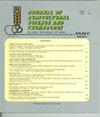黄粉虫(tenbrio molitor L.)的饲料补充改善肉鸡血液特性和肉质
IF 1.3
4区 农林科学
Q2 AGRICULTURE, MULTIDISCIPLINARY
引用次数: 9
摘要
本试验旨在研究黄粉虫(YM)和黄粉虫(SM)的秸秆作为肉仔鸡蛋白质来源的效果。选取200只爱拔亩、日龄的肉仔鸡,随机分为5个处理(对照、0.5%豆粕、1.0%豆粕、2.0%豆粕和1.0%豆粕),每2个重复,饲喂6周。饲喂试验结束后采集血液和肉样。1.0% YM处理的体增重最高。饲料需求在1.0% YM处理时最低。对粉虫的适口性和质地均无不良影响。活重和胴体重显著高于对照组(P<0.05)。1.0% YM处理胴体品质最高。与感染相关的白细胞不受粉虫补充的影响。与贫血相关的红细胞在各添加组均显著升高(P<0.05)。血清各成分添加组均高于对照组。但未见病理性及代谢性疾病。饲粮添加组粗蛋白质、粗脂肪和粗灰分较高,肉色a*和b*显著(P<0.05)高于1.0% YM处理。热损失和剪切力有所降低。添加粉虫后,饱和脂肪酸减少,不饱和脂肪酸增加。因此,添加脂肪酸可以改善肉鸡肉中的脂肪酸组成。综上所述,黄粉虫是肉鸡良好的蛋白质来源,对肉鸡无不良影响。本文章由计算机程序翻译,如有差异,请以英文原文为准。
Feed Supplementation of Yellow Mealworms (Tenebrio molitor L.) Improves Blood Characteristics and Meat Quality in Broiler
This experiment was conducted to test yellow mealworm (YM) and slough of mealworm (SM) supplementation as protein sources in broiler. Two-hundred broilers (Arbor acres, day old) were randomly assigned in five treatments (control, 0.5% YM, 1.0% YM, 2.0% YM, and 1.0% SM) with 2 replicates and then fed 6 weeks. Blood and meat samples were collected after feeding trial. Body weight gain was the highest in 1.0% YM treatment. Feed requirement was lowest in 1.0% YM treatment. There were no negative effect on palatability and texture of mealworm. Live weight and carcass weight were significantly (P<0.05) higher than in control. Carcass quality was highest in 1.0% YM treatment. WBC, which were related to infection, was not affected by mealworm supplementation. RBC, which were related to anemia, was significantly (P<0.05) increased in all supplementation groups. Serum components were higher in supplementation group than in control group. However, there were no pathological and metabolic disease. Crude protein, crude fat, and crude ash were high in supplementation group, and meat color a* and b* were significantly (P<0.05) high in 1.0% YM treatment. Heating loss and shear force were reduced a little. By mealworm supplementation, saturated fatty acid was reduced and unsaturated fatty acid was increased. Therefore, fatty acid composition was improved by supplementation in broiler meat. In conclusion, yellow mealworm would be a good protein source for broiler without any detrimental effect.
求助全文
通过发布文献求助,成功后即可免费获取论文全文。
去求助
来源期刊

Journal of Agricultural Science and Technology
AGRICULTURE, MULTIDISCIPLINARY-
CiteScore
1.90
自引率
8.30%
发文量
0
审稿时长
4.5 months
期刊介绍:
Journal of Agricultural Science and Technology is one of the TMU Press journals that is published by the responsibility of its Editor-in-Chief and Editorial Board in the determined scopes.
Journal of Agricultural Science and Technology (JAST) is an international research journal published bimonthly for the purpose of advancing the scientific studies. The subjects covered by JAST include all aspects of agriculture and natural resources (see Areas Covered). The journal will consider submissions from all over the world, on research works not being published or submitted for publication towards publication as full paper, review article and research note. The Papers are published in English with an extra abstract in Persian.
 求助内容:
求助内容: 应助结果提醒方式:
应助结果提醒方式:


